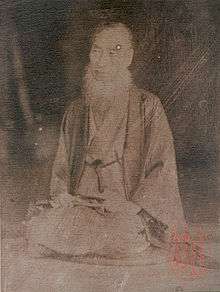Takahashi Yuichi
| Takahashi Yuichi | |
|---|---|
 Takahashi Yuichi | |
| Born |
March 20, 1826 Edo Japan |
| Died |
July 6, 1894 (aged 68) Tokyo, Japan |
| Nationality | Japanese |
| Known for | Painter, |
| Movement | Yōga |
Takahashi Yuichi (高橋 由一, March 20, 1828 – July 6, 1894) was a Japanese painter, noted for his pioneering work in developing the yōga (Western-style) art movement in late 19th-century Japanese painting.
Biography
Takahashi was born to an samurai class household at the Edo residence of Sano Domain, a subsidiary han of Sakura Domain, where his father was a retainer of the Hotta clan. Interested in art from childhood, he apprenticed to the Kanō school, but later became fascinated with western-style art through lithographs which were being available in Japan during the Bakumatsu period. In 1862, he obtained a position at arts department the Bansho Shirabesho, the Tokugawa shogunate’s research institute in western learning, where he studied under Kawakami Togai, and where he began experimentation with oil painting. In 1866, he went to Yokohama to study under the English artist and cartoonist Charles Wirgman, who was so impressed with his talent that he sponsored his participation in the Paris World Exhibition of 1867.
After the Meiji Restoration, despite his largely self-taught credentials, he was appointed a professor of art at the Kobubijutsu Gakkō (the Technical Fine Arts School) by the new Meiji government, and was a student and an assistant for the Italian foreign advisor Antonio Fontanesi, who had been hired by the Meiji government in the late 1870s to introduce western oil painting to Japan.
.jpg)
In 1879, he entered a contest sponsored by the Kotohira-gū shrine in Shikoku for ceiling panel paintings, donating all of the paintings to the shrine after the contest. The shrine still displays a collection of 27 of his paintings. Also in 1879, Takahashi was recommended by the Genrōin to become a court painter, and was allowed to paint a portrait of Emperor Meiji. In 1881, he received a large commission from Viscount Mishima Michitsune to paint scenes of public works projects in Yamagata prefecture.
Although Takahashi produced mostly portraiture and landscape paintings, he best-known work is a still life of a salmon, which has been recognized by the Agency for Cultural Affairs of the Japanese government as an Important Cultural Property of Japan.
Noted works
- Beauty (美人 bijin), 1872, Tokyo University of the Arts, National Important Cultural Property
- Salmon (鮭 sake), 1877, Tokyo University of the Arts, National Important Cultural Property
References
- Keene, Donald. Dawn to the West. Columbia University Press; (1998). ISBN 0-231-11435-4
- Mason, Penelope. History of Japanese Art . Prentice Hall (2005). ISBN 0-13-117602-1
- Miyoshi, Masao. Postmodernism and Japan. Duke University Press (1986) ISBN 0-8223-0896-7
- Sadao, Tsuneko. Discovering the Arts of Japan: A Historical Overview. Kodansha International (2003). ISBN 4-7700-2939-X
- Schaarschmidt Richte. Japanese Modern Art Painting From 1910 . Edition Stemmle. ISBN 3-908161-85-1
- Weisenfeld, Gennifer. MAVO: Japanese Artists and the Avant-Garde, 1905–1931. University of California Press (2001). ISBN 0-520-22338-1
External links
![]() Media related to Takahashi Yuichi at Wikimedia Commons
Media related to Takahashi Yuichi at Wikimedia Commons